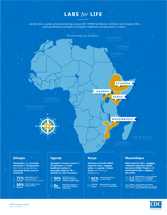Publications
November 2013 - Effectiveness of Structural-Level Needle/Syringe Programs to Reduce HCV and HIV Infection Among People Who Inject Drugs: A Systematic Review. Needle-syringe programs (NSP) have been effective in reducing HIV and hepatitis C (HCV) infection among people who inject drugs (PWID). Achieving sustainable reductions in these blood-borne infections requires addressing structural factors so PWID can legally access NSP services. Systematic literature searches collected information on NSP coverage and changes in HIV or HCV infection prevalence or incidence at the population level. Included studies had to document bio markers (HIV or HCV) coupled with structural-level NSP, defined by a minimum 50 % coverage of PWID and distribution of 10 or more needles/syringe per PWID per year. Fifteen studies reported structural-level NSP and changes in HIV or HCV infection prevalence/incidence. Nine reported decreases in HIV prevalence, six in HCV infection prevalence, and three reported decreases in HIV incidence. The results support NSP as a structural-level intervention to reduce population-level infection and implementation of NSP for prevention and treatment of HIV and HCV infection.
October 15, 2013 - Recent Patterns in Population-Based HIV Prevalence in Swaziland. The 2011 Swaziland HIV Incidence Measurement Survey (SHIMS) was conducted as part of a national study to evaluate the scale up of key HIV prevention programs. From a randomly selected sample of all Swazi households, all women and men aged 18-49 were considered eligible, and all consenting adults were enrolled and received HIV testing and counseling. In this analysis, population-based measures of HIV prevalence were produced and compared against similarly measured HIV prevalence estimates from the 2006-7 Swaziland Demographic and Health. Also, measures of HIV service utilization in both HIV infected and uninfected populations were documented and discussed.
August, 2013 - PAMWE - Together: A public health magazine published by CDC-Namibia. Celebrating health Care Workers in Northern Namibia: Supporting and AIDS-Free Generation (Volume 3, Issue 2)
August 15, 2013 - Retention of participants in medication-assisted programs in low- and middle-income countries: an international systematic review. Medication-assisted treatment (MAT) is a key component in overdose prevention, reducing illicit opiate use and risk of blood-borne virus infection. By retaining participants in MAT programs for longer periods of time, more noticeable and permanent changes in drug use, risk behavior and quality of life can be achieved. Many studies have documented retention in MAT programs in high-income countries, using a 50% average 12-month follow-up retention rate as a marker for a successful MAT program. This study contributes to a systematic understanding of how successful programs have been in retaining participants in low- and middle-income countries (LMIC) over time.
June, 2013 - Using Science to Save Lives: CDC and the Fight against Global HIV/AIDS (2013) describes progress made by the United States and the world community to save millions of lives and turn the tide in the HIV/AIDS epidemic.
February 20, 2013 - New Institutes of Medicine (IOM) Report: Evaluation of PEPFAR
This 650-page assessment was released by IOM on February 20, 2013. Ambassador Eric Goosby, U.S. Global AIDS Coordinator, called the new report "a strong validation of PEPFAR’s ongoing commitment to saving lives through smart investments."
October 7, 2011 - Assessment of antiretroviral therapy knowledge and willingness of persons with HIV to support its uptake in Uganda. Access to care and treatment services for HIV/AIDS are hampered by human resource constraints and knowledge gaps about antiretroviral therapy. The aim of this study was to assess the antiretroviral therapy-specific knowledge, beliefs, and attitudes of people with HIV/AIDS as well as their proactive communication with community members and to explore their willingness to serve as support personnel.
August 2011 - Cost-effectiveness analysis of diagnostic options for pneumocystis pneumonia (PCP). Diagnosis of PCP is challenging, particularly in developing countries. Highly sensitive diagnostic methods are costly, while less expensive methods often lack sensitivity or specificity.
June 2, 2011 - A comprehensive evaluation of the proficiency testing program for the HIV-1 BED incidence assay. The HIV-1 BED incidence assay was developed at the CDC to detect and distinguish recent from long-term HIV-1 infection and since 2005 has been available as a commercial kit for use in HIV-1 incidence surveillance.
May 2011 - Cost-effectiveness of HIV screening in STD clinics, emergency departments, and inpatient units: a model-based analysis. Identifying and treating persons with HIV infection early in their disease stage is considered an effective means of reducing the impact of the disease. We compared the cost-effectiveness of HIV screening in three settings, sexually transmitted disease (STD) clinics serving men who have sex with men, hospital emergency departments, settings where patients are likely to be diagnosed early, and inpatient diagnosis based on clinical manifestations.
March 2011 - Assessment of BED HIV-1 incidence assay in seroconverter cohorts: effect of individuals with long-term infection and importance of stable incidence. Performance of the BED assay in estimating HIV-1 incidence has previously been evaluated by using longitudinal specimens from persons with incident HIV infections, but questions remain about its accuracy. We sought to assess its performance in three longitudinal cohorts from Thailand where HIV-1 CRF01_AE and subtype B' dominate the epidemic.
March 2011 - HIV-1 drug resistance emergence among breastfeeding infants born to HIV-infected mothers during a single-arm trial of triple-antiretroviral prophylaxis for prevention of mother-to-child transmission: a secondary analysis. Nevirapine and lamivudine given to mothers are transmitted to infants via breastfeeding in quantities sufficient to have biologic effects on the virus; this may lead to an increased risk of a breastfed infant's development of resistance to maternal antiretrovirals. Here, we present findings from a Kisumu Breastfeeding Study trial secondary analysis that evaluated the emergence of maternal ARV-associated resistance among 32 HIV-infected breastfed infants.
Labs for Life Infographic:

Get email updates
To receive email updates about this page, enter your email address:
Contact Us:
- Centers for Disease Control and Prevention
1600 Clifton Rd
Atlanta, GA 30333 - 800-CDC-INFO
(800-232-4636)
TTY: (888) 232-6348
24 Hours/Every Day - Contact CDC-INFO
 ShareCompartir
ShareCompartir


